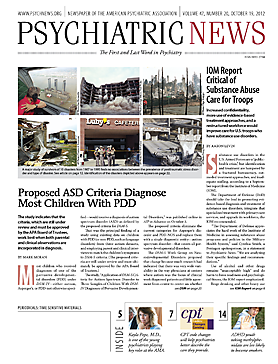Most children who received diagnoses of one of the pervasive developmental disorders (PDD) under DSM-IV—either autism, Asperger’s, or PDD-not otherwise specified—would receive a diagnosis of autism spectrum disorder (ASD) as defined by the proposed criteria for DSM-5.
That was the principal finding of a study using existing data on children with PDD (or non-PDD, such as language disorders) from three autism datasets, and employing parent and clinical interviews to match the children’s symptoms to DSM-5 criteria. (The proposed criteria are still under review and must ultimately be approved by the APA Board of Trustees.)
The study, “Application of DSM-5 Criteria for Autism Spectrum Disorder to Three Samples of Children With DSM-IV Diagnoses of Pervasive Developmental Disorders,” was published online in AJP in Advance on October 3.
The proposed criteria eliminate the current categories for Asperger’s disorder and PDD-NOS and replace them with a single diagnostic entity—autism spectrum disorder—that covers all pervasive developmental disorders.
The DSM-5 Work Group on Neurodevelopmental Disorders proposed that change because much research had indicated that there was very wide variability in the way physicians at centers where autism was the focus of clinical work diagnosed patients and little agreement from center to center on whether patients received a diagnosis of autism, Asperger’s, or PDD-NOS (Psychiatric News, February 3).
The new study found that on the basis of parent-reported symptoms only, the sensitivity of the proposed DSM-5 criteria ranged from 0.89 to 0.93, depending on the number of symptoms present—that is, 89 percent to 93 percent of children diagnosed under DSM-IV also met the proposed criteria for DSM-5. On the basis of either parent report or clinical observation, DSM-5 sensitivity ranged from 0.97 to 0.99 for any PDD.
Study coauthor Catherine Lord, Ph.D., told Psychiatric News that virtually all of the children who did not meet DSM-5 criteria for ASD warranted a diagnosis for social communication disorder, other language disorders, or attention-deficit/hyperactivity disorder.
Moreover, the specificity—or ability of the criteria to avoid misclassifying noncases as true cases—was roughly similar to that for DSM-IV and was superior when both parent and clinical observations were incorporated.
That’s crucial, Lord said, because it demonstrates the value of incorporating parental observations along with clinical judgment in diagnosing pervasive devel opmental disorders.
Lord said the intent of the proposed criteria was to outline broad descriptors of PDD—such as repetitive behaviors—and allow clinicians to use their judgment in determining if children fit the criteria. The study shows that parental observations can be useful in that determination, she said.
The findings would seem to answer the concerns of parents and some autism experts that the proposed criteria would exclude from diagnosis—and therefore from services and treatment—many children who currently meet DSM-IV criteria.
“All of our data to date suggest that if you look at these patients carefully and understand the intent of the proposed criteria—which is to state broad principles and leave it up to the clinician working with the patient or parent to observe examples of behaviors that fit the principles—it would be very surprising if there are many patients [currently meeting DSM-IV diagnoses] who would not fit the new criteria,” Lord told Psychiatric News.
In the study, datasets on 4,453 children with DSM-IV clinical PDD diagnoses and 690 with non-PDD diagnoses (such as language disorder) were drawn from three sources: the Simons Simplex Collection, a genetic consortium including families having just one child with an ASD; the Collaborative Programs of Excellence in Autism, a multicenter study of ASD; and the University of Michigan Autism and Communication Disorders Center data bank.
Items from a parent report measure of ASD symptoms (Autism Diagnostic Interview-Revised) and a clinical observation instrument (Autism Diagnostic Observation Schedule) were matched to DSM-5 criteria and used to evaluate the sensitivity and specificity of the proposed DSM-5 criteria compared to clinical diagnoses using DSM-IV criteria.
Lord and colleagues found that using the parent data alone, the proposed DSM-5 criteria identified 91 percent of children with clinical DSM-IV PDD diagnoses and that the sensitivity remained high in specific subgroups, including girls and children under age 4.
The concern within the community of autism patients and clinicians that some currently diagnosed patients would be overlooked by the new criteria has been one of the widely discussed topics—on the Internet and elsewhere—about the DSM-5 proposals.
But Lord said families that are concerned should consult with a trusted clinician familiar with the proposed criteria. “The study should answer those concerns about as well as anything using preexisting data can,” Lord said. “The intention of the proposed criteria is to include anyone who had a clinical diagnosis of any autism spectrum disorder (under
DSM-IV).” 

